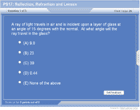| How to Learn in 24 Hours? |
|
| Need Help? |
M-F: 9am-5pm(PST):
Toll-Free: (877) RAPID-10
or 1-877-727-4310
24/7 Online Technical Support:
The Rapid Support Center
vip@rapidlearningcenter.com
Secure Online Order:

|
| Tell-A-Friend: |
Have friends taking science and math courses too? Tell them about our rapid learning system.
|
|
Reflection, Refraction and Lenses
| Topic Review on "Title": |
Law of reflection:
- The angle of incidence equals the angle of reflection.
Diffuse reflection:
- Reflection from a rough surface where variations in the direction of the surface cause light to reflect in different directions.
Convex mirror:
- Also called a diverging mirror, a surface that diverges light as if it originates from a point behind the mirror, a focal point.
Concave mirror:
- Also, called a converging mirror, a surface that converges light to a single point, focal point.
Real image:
- An image where the rays of light actually meet at a location. It can be projected onto a screen.
Virtual image:
- An image that cannot be projected onto a screen. The rays of light don’t actually converge there, they just seem to originate from that location.
Refraction:
- The bending of light due to its change in velocity in various media.
Index of refraction:
- The ratio between the speed of light in a vacuum and a particular medium.
Snell’s law:
- The formula that describes the amount of refraction of light based on the two different media and the angle of the light ray: n1sinθ1=n2sinθ2
Total internal reflection:
- The complete reflection of light when it strikes the boundary between two media at greater than a critical angle.
Convex lens:
- A converging lens that gathers incoming light to a single focal point.
Concave lens:
- A diverging lens that diverges light as if it originates from a point behing the lens, the focal point.
Spherical aberration:
- A lens defect where light is imperfectly focused near the focal point.
Chromatic aberration:
- A lens defect where various color focus at different locations.
|
| Rapid Study Kit for "Title": |
| Flash Movie |
Flash Game |
Flash Card |
| Core Concept Tutorial |
Problem Solving Drill |
Review Cheat Sheet |
 |
 |
 |
|
| "Title" Tutorial Summary : |
Light can reflect as it bounces off a sufficiently smooth barrier. In doing this, it will obey the law of reflection that says the incident angle is equal to the reflected angle. Reflection can also occur for curved mirrors, both convex and concave. In these instances, real or virtual images can be formed. Ray diagrams can be used to trace the behavior of light and determine the image. The mirror formula can also be used to calculate variables. When light passes into transparent materials, it may refract or bend. Snell’s law describes this quantitatively. Sometimes the light is bend so much that it doesn’t emerge from the transparent material. This is called total internal reflection. This bending of light is the basic behind the operation of a lens. Convex and concave lenses can form real and virtual images too. Again, both ray diagrams and the lens equation can be used to describe the resulting image.
|
| Tutorial Features: |
Specific Tutorial Features:
• Many animated ray diagrams for mirrors and lenses showing image formation.
• Examples with step by step assistance to solve problems.
Series Features:
• Concept map showing inter-connections of new concepts in this tutorial and those previously introduced.
• Definition slides introduce terms as they are needed.
• Visual representation of concepts
• Animated examples—worked out step by step
• A concise summary is given at the conclusion of the tutorial.
|
| "Title" Topic List: |
Plane mirrors
Law of reflection
Virtual images
Diffuse reflection
Importance or wavelength
Curved mirrors
Concave mirror ray diagram
Convex mirror ray diagram
Mirror equation and example
Magnification equation and example
Refraction
Index of refraction
Refraction example and analogy
Snell’s law
Dispersion
Total internal reflection
Fiber optics
Lenses
Convex lens ray diagram
Concave lens ray diagram
Lens equation and example
Lens combinations
Lens defects
|
See all 24 lessons in high school physics, including concept tutorials, problem drills and cheat sheets:
Teach Yourself High School Physics Visually in 24 Hours
|



